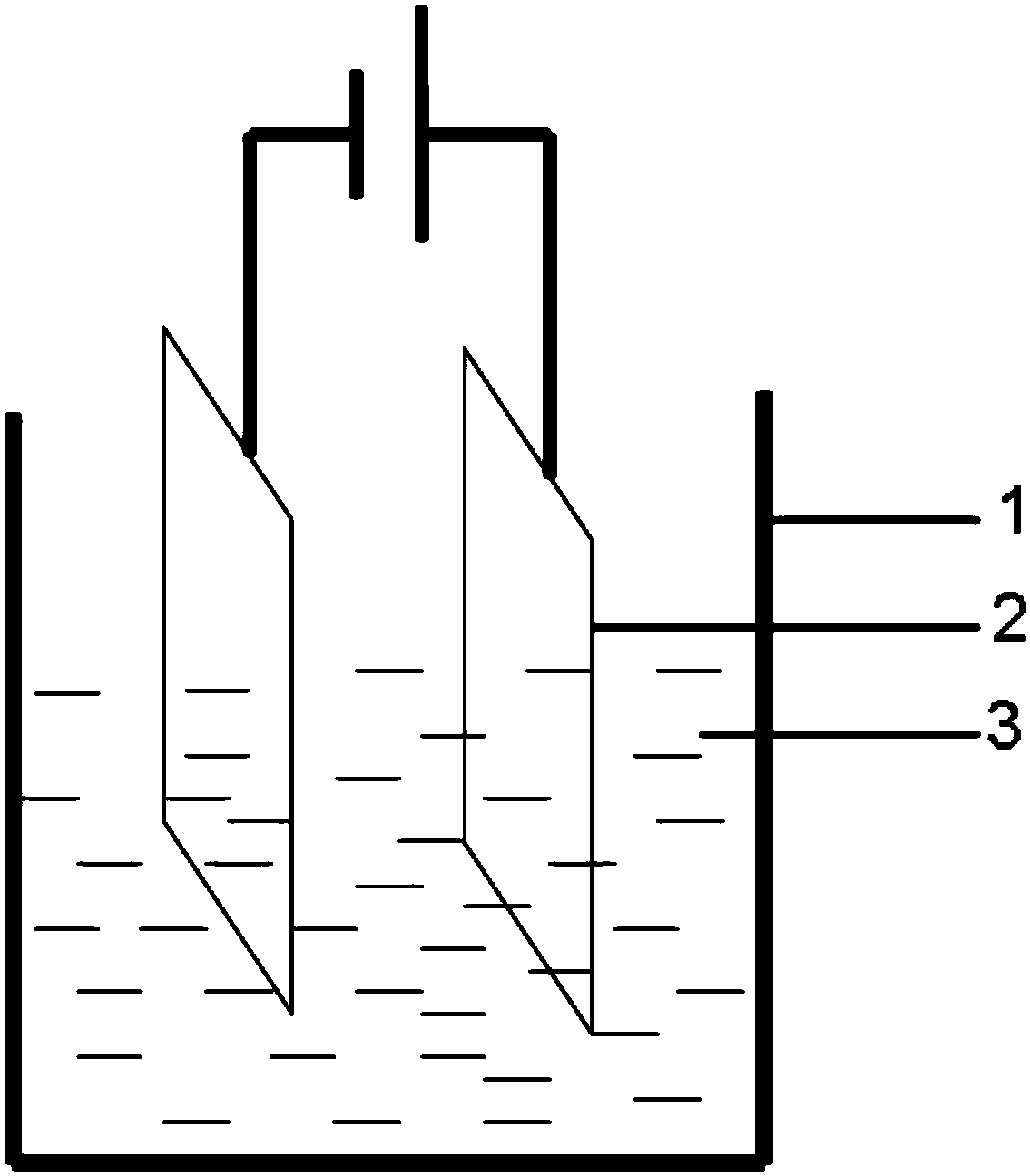A kind of preparation method of antimony sulfide film
A technology of antimony sulfide film and antimony sulfide, applied in the direction of electrolytic inorganic material coating, etc., can solve the problems of poor process controllability, sample waste, and inapplicability of a small amount of precious samples, so as to avoid barrier effect, short reaction time and high yield high effect
- Summary
- Abstract
- Description
- Claims
- Application Information
AI Technical Summary
Problems solved by technology
Method used
Image
Examples
Embodiment 1
[0024] Conductive glass (ITO) was ultrasonically cleaned in acetone and ethanol solutions for 15 minutes, and then rinsed with deionized water; 0.02gSb 2 S 3 Add to 10ml 1,2-ethylenediamine and 1ml 1,2-ethanedithiol mixed solvent, stir and dissolve at room temperature to prepare electrodeposition solution; figure 1 As shown, two pieces of conductive glass 2 are used as the working electrode and the counter electrode, and are vertically arranged in the electrolytic cell 1 equipped with the above-mentioned electrodeposition solution 3. The electrode surfaces are parallel to each other, and the cathode constant potential electrodeposition is carried out at a voltage of 4V. The time is 30 minutes. After the electrodeposition is completed, a uniform and dense film is deposited on the conductive glass. The electrodeposited film is heat-treated at 400° C. for 3 minutes under nitrogen gas, and cooled to room temperature to obtain an antimony sulfide film.
[0025] like figure 2 As ...
Embodiment 2
[0028] Conductive glass (FTO) was ultrasonically cleaned in acetone and ethanol solutions for 15 minutes, and then rinsed with deionized water; 0.03gSb 2 S 3 Add it to a mixed solvent of 10ml 1,2-ethylenediamine and 1ml 1,2-ethanedithiol, stir and dissolve at room temperature to obtain an electrodeposition solution; use two pieces of conductive glass as the working electrode and the counter electrode, and put them in a vertical arrangement In the electrolytic tank with the above-mentioned electrodeposition solution, the electrode surfaces are parallel to each other, and the cathode constant potential electrodeposition is carried out, the voltage is 8V, and the electroplating time is 5min. After the electrodeposition is completed, a layer of uniform and dense film is deposited on the conductive glass. The electrodeposited film was heat-treated at 300° C. for 1 minute under nitrogen gas, and cooled to room temperature to obtain an antimony sulfide film.
Embodiment 3
[0030] Conductive glass (AZO) was ultrasonically cleaned in acetone and ethanol solutions for 15 minutes, and then rinsed with deionized water; 0.01gSb 2 S 3 Add it to a mixed solvent of 10ml 1,2-ethylenediamine and 1ml 1,2-ethanedithiol, stir and dissolve at room temperature to obtain an electrodeposition solution; use two pieces of conductive glass as the working electrode and the counter electrode, and put them in a vertical arrangement In the electrolytic tank with the above-mentioned electrodeposition solution, the electrode surfaces are parallel to each other, and the cathode constant potential electrodeposition is carried out, the voltage is 1.5V, and the electroplating time is 10min. After the electrodeposition is completed, a layer of uniform and dense film is deposited on the conductive glass. The electrodeposited film was heat-treated at 350° C. for 10 minutes under nitrogen gas, and then cooled to room temperature to obtain an antimony sulfide film.
PUM
 Login to View More
Login to View More Abstract
Description
Claims
Application Information
 Login to View More
Login to View More - R&D
- Intellectual Property
- Life Sciences
- Materials
- Tech Scout
- Unparalleled Data Quality
- Higher Quality Content
- 60% Fewer Hallucinations
Browse by: Latest US Patents, China's latest patents, Technical Efficacy Thesaurus, Application Domain, Technology Topic, Popular Technical Reports.
© 2025 PatSnap. All rights reserved.Legal|Privacy policy|Modern Slavery Act Transparency Statement|Sitemap|About US| Contact US: help@patsnap.com



